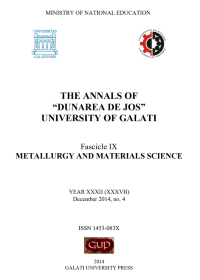Influence of Cooling Oil on the Surface Quality of the Rolled Strip
Abstract
The excess of emulsion used in the lamination process leads to the formation of drops which in the annealing process forms spots of burned emulsion. It was also shown to cause formation areas with high carbon concentrations on the surface of the steel strips, after annealing. In the cold rolling process, the surface of the rolled strip is contaminated by cooling oil or emulsion and other chemical compounds, which could considerably influence the final quality of the strip.
The microscopic analysis of the spots of burned emulsion showed a complex phase structure resulting from the combustion rate through the interaction between the emulsion and the contaminating residues, as well as the one between the emulsion and the steel substrate.
Downloads
References
[2]. M. Raulf, T. Brixius, H. Duchaczek, Optimisation of rolling lubricants for improved operation of cold rolling mills (Optilub), 2009.
[3]. P. Pathak, S. K. Jha, A. Singh, Tribological Approach for Improvement in Productivity and Quality of Flat Rolled Steel Products: A Review, International Journal of Technical Research (IJTR), Vol. 1, Issue 1, Mar-Apr 2012.
[4]. Tamara Radu, Anişoara Ciocan, Behaviour of cold rolling emulsions in the obtaining process of steel strips, International conference, UGALMAT 2014, 29 -30 May, Galati, Romania.
[5]. Lucica Balint,Maria Vlad,Dumitru DimaIoan, Simion Balint, Characterization of the emulsions used for cold rolling steel strips with the view of their valorisation, 14th Geoconference SGEM 2014, Albena, Bulgaria, p. 43-51, 2014.
[6]. ***, Defect Catalog Extract http://www.slideshare.net.
[7]. ***, Defects Atlas for surface defects on Cold Rolled Steel, www.iitk.ac.in.
[8]. ***, Atlas de defecte de suprafata a benzilor laminate la rece, Arcelor Mittal.
[9]. F. Potecasu, Stiinta si ingineria materialelor - Galati, Editura Europlus Galati – ISBN 973-7845-10-2, ISBN 978-973-7845-10-8, 2006.
[10]. S. R. Schmid, W. D. Wilson, Lubrification mechanisms for oil-in-water emulsions, Lubrification Engineering, vol. 52, 2, p. 168-175, 1996.
[11]. T. Radu, A. Ciocan, F. Potecașu, S. Constantinescu, L. Balint, C. Eni, Influence of cold rolling emulsion on the steel strips surface quality, Symposium of Croatian Metallurgical Society “SHMD 2014”, Rev. Metallurgy, vol. 53, Br./No. 3, Str./p. 289-432.
[12]. K. Hyunok, K. Nimet, Friction and lubrication, Sheet Metal Forming Fundamentals 20.



